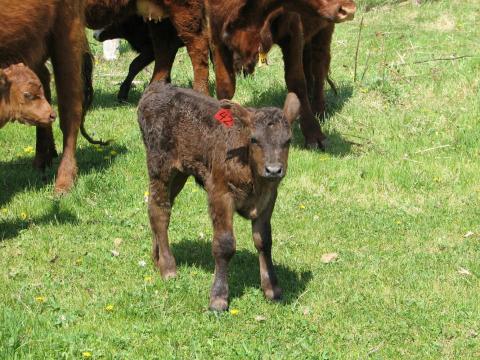When Calves Start A-Droppin’, Don’t Come A-Knockin’

We’re seeing the first signs of spring in New Hampshire — boiling sap, longer days, mud, and for some fresh baby calves. It’s an exciting time of year, but calving season can be stressful for farmers in New Hampshire. The economic impact of a successful calving is important for each and every cow. Between unpredictable weather patterns, meeting nutritional needs for animals who have been without pasture for months, and other day-to-day duties around the farm, being fully prepared to get through the season is a task unto itself.
We thought we’d help you prepare with this review of basic considerations to prepare for a smooth calving season.
1. Prepare your “Calving Kit”
It’s important to have everything you might need to assist with calving organized and in an easy to find location on the farm.
A Calving Kit might include:
- Disposable long sleeve obstetrical (OB) gloves
- OB lubricant
- Esophageal feeders and/ or calf feeding bottles
- Calf jack, obstetric chains and/ or straps
- Flashlights—test to make sure they are working well
- Halter and rope
- Oxytocin or epinephrine
- Disinfection (iodine) for dipping navel
- Sterile syringes and needles
- Electrolytes
- Ear tags
- Necessary equipment for castration (if doing immediately postcalving)
2. Evaluate cow and first-calf heifer nutritional needs prior to calving.
Evaluate body condition score 90 days before calving so you have time to improve their condition if needed, and then again at calving time to assess your pre-calving feeding program.
Having cows in good condition is essential for the final stages of calf growth, quality colostrum production, calf vigor, and later rebreeding. Adjustments to feeding programs should be made in the last trimester of pregnancy, so around 50-60 days prior to calving. Pay special attention to your younger stock (heifers) as they are still growing themselves, while also growing a calf. Considering the added stresses of weather conditions, calving for the first time, and on-set of lactation it is essential to make sure these girls have plenty of access to quality feed, water, and minerals without competition.
3. Review your herd health plan with your veterinarian.
Don’t let calving season be the first time you have a conversation with a veterinarian. Develop a veterinary-client-patient-relationship (VCPR) so that, together as a team, you can develop a whole herd plan to minimize risk, identify critical control points, and maintain overall herd health in a cost effective manner. Take the time prior to calving season to discuss your herd’s history and management system with your veterinarian so that they can recommend a vaccination program and herd health plan specific to your needs.
4. Sanitize and examine facilities.
Do a walk-through of your calving facilities. Make sure gates, handling facilities, waters, feeders, lights, etc. are all in working condition and replace if broken. Cleanliness of facilities is also important to prevent the spread of disease in this delicate and vulnerable time for your herd. Sanitize and/ or pressure wash any part of the facilities that can be cleaned and place fresh, clean bedding in the calving areas or pens.
5. Review stages of parturition and when you would need to assist.
There are a lot of great Cooperative Extension resources to help learn and better understand when to intervene during calving. One article from University of Nebraska Lincoln Extension goes into great detail about the stages of pregnancy, factors that cause difficult births, and how to prepare for assistance http://extensionpublications.unl.edu/assets/pdf/ec1907.pdf. This is a crucial time for the mother and the calf, so the most important thing is to know your limitations and when to call the veterinarian when necessary.
6. Have colostrum or quality colostrum replacer on hand.
Colostrum, the first secretions of lactation, is essential for calf vitality and success. Calves are born without any kind of immunity, so colostrum contains all the antibodies necessary for calf survival—think of it as your first vaccination. Often, calves do not survive due to inadequate passive transfer from lack of colostrum. This is critical, as the window for absorption decreases 12 hours after birth. Calves should get about 5-6% of their body weight in the first 6 hours of life and again at 12 hours (this usually equates to 2 quarts of colostrum per feeding). The best way for calves to get the colostrum they need is by suckling the dam. If the calf is unable to do this, you may need to intervene. Frozen colostrum from your own herd or commercially available colostrum replacer are good to have on hand, just in case.
7. Have a plan to protect from cold weather and wind.
As we know, New England weather can be quite fickle so make sure your calving facilities are in an area protected from extreme weather conditions. Calves born in wet, cold conditions are extremely susceptible to hypothermia. Have a plan and a place where you can pull a calf in to warm them up, give a hot bath and feed them warm colostrum.
8. Record keeping: plan and review
Finally, this wouldn’t be an extension blog if we didn’t throw in a business component! Take time prior to the calving season to review records and adjust your system to keep track of new records. Things you might note are calving ease, birth date, identification, sex, sire and weight. You might also want to record observations of your cow such as body condition, udder condition, dystocia and temperature.
Want to Know More?
If you’re interested in learning more about preparing for the calving season and considerations when it comes to cow-calf management, please join us on April 18th, 2020 at Overlook Farm for a Beef Cattle Pregnancy and Calving Workshop from 1pm-4pm. This workshop was organized in partnership with the New Hampshire Beef Producers Association. For more information and to register you can click on the workshop title above.
Sources:
https://extension.psu.edu/calving-season-preparation
https://beef.unl.edu/preparing-calving
https://extension.sdstate.edu/preparing-calving-season